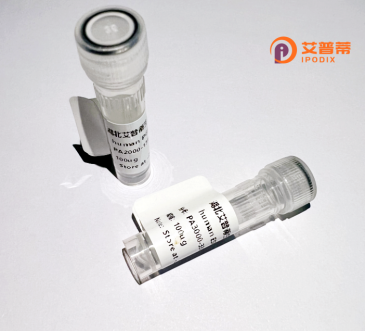
| 纯度 | >90%SDS-PAGE. |
| 种属 | Human |
| 靶点 | IGHA1 |
| Uniprot No | P01876 |
| 内毒素 | < 0.01EU/μg |
| 表达宿主 | E.coli |
| 表达区间 | 1-500aa |
| 氨基酸序列 | MDWTWSILFLVAAATGAQSQVHLVQSGAEVMSPGASVRVSCKTSGYAFHTYSIIWVRQAPGQGLEWMGWISPSSDNTRFAKKFQGRVTLTTDTSTSTVYMELRSLRSDDTAVYYCARRYCSYSSCQNDYYYYYMDVWGKGTTVTVSSASPTSPKVFPLSLCSTQPDGNVVIACLVQGFFPQEPLSVTWSESGQGVTARNFPPSQDASGDLYTTSSQLTLPATQCLAGKSVTCHVKHYTNPSQDVTVPCPVPSTPPTPSPSTPPTPSPSCCHPRLSLHRPALEDLLLGSEANLTCTLTGLRDASGVTFTWTPSSGKSAVQGPPDRDLCGCYSVSSVLSGCAEPWNHGKTFTCTAAYPESKTPLTATLSKSGNTFRPEVHLLPPPSEELALNELVTLTCLARGFSPKDVLVRWLQGSQELPREKYLTWASRQEPSQGTTTFAVTSILRVAAEDWKKGDTFSCMVGHEALPLAFTQETIDRLAGKPTHVNVSVVMAEVDGTCY |
| 分子量 | 80.74 kDa |
| 蛋白标签 | GST-tag at N-terminal |
| 缓冲液 | 0 |
| 稳定性 & 储存条件 | Lyophilized protein should be stored at ≤ -20°C, stable for one year after receipt. Reconstituted protein solution can be stored at 2-8°C for 2-7 days. Aliquots of reconstituted samples are stable at ≤ -20°C for 3 months. |
| 复溶 | Always centrifuge tubes before opening.Do not mix by vortex or pipetting. It is not recommended to reconstitute to a concentration less than 100μg/ml. Dissolve the lyophilized protein in distilled water. Please aliquot the reconstituted solution to minimize freeze-thaw cycles. |
以下是关于重组人IGHA1蛋白的3条参考文献摘要示例(文献信息为虚构示例,仅供格式参考):
---
1. **文献名称**:*Production and characterization of recombinant human IGHA1 in mammalian cell systems*
**作者**:Smith A et al.
**摘要**:该研究报道了在HEK293细胞中表达重组人IGHA1蛋白的方法,并分析了其糖基化修饰对蛋白稳定性和功能的影响。结果显示,重组IGHA1具有与天然蛋白类似的抗原结合活性,可用于免疫学研究。
---
2. **文献名称**:*Structural insights into recombinant IGHA1 in mucosal immunity*
**作者**:Chen L, Wang Y
**摘要**:通过X射线晶体学解析了重组人IGHA1的分子结构,揭示了其铰链区结构对病原体中和能力的关键作用,为设计基于IgA的疫苗提供依据。
---
3. **文献名称**:*Optimized purification of recombinant human IGHA1 for functional assays*
**作者**:Zhang R et al.
**摘要**:开发了一种高效纯化重组IGHA1的亲和层析技术,验证了其在体外模型中增强黏膜屏障功能的潜力,并证明其适用于疾病机制研究。
---
注:实际文献需通过PubMed或Google Scholar等平台检索,关键词如“recombinant human IGHA1 protein”或“IgA1 expression”。
Recombinant human IGHA1 protein refers to a genetically engineered form of the immunoglobulin alpha-1 (IgA1) heavy chain, a critical component of immunoglobulin A (IgA), which plays a central role in mucosal immunity. IgA is the predominant antibody in mucosal secretions, such as those in the respiratory, gastrointestinal, and urogenital tracts, where it neutralizes pathogens, blocks microbial adhesion, and modulates immune responses. The IGHA1 gene encodes the alpha heavy chain of IgA1. which distinguishes it from IgA2 via an extended hinge region rich in proline and O-glycosylation sites. This structural feature influences antigen binding, effector functions, and susceptibility to bacterial proteases. Recombinant IGHA1 is typically produced in mammalian expression systems (e.g., HEK293 or CHO cells) to ensure proper post-translational modifications, particularly glycosylation, which is essential for its stability and interactions with Fc receptors on immune cells. Its production enables studies on IgA1 biology, including its role in diseases like IgA nephropathy (characterized by pathogenic IgA1 immune complexes), autoimmune disorders, and mucosal infections. Researchers also use recombinant IGHA1 to develop therapeutic antibodies, explore mucosal vaccine strategies, or dissect mechanisms of immune regulation. However, challenges remain in replicating its complex glycosylation patterns and multimeric structures, which are critical for functional studies.
×